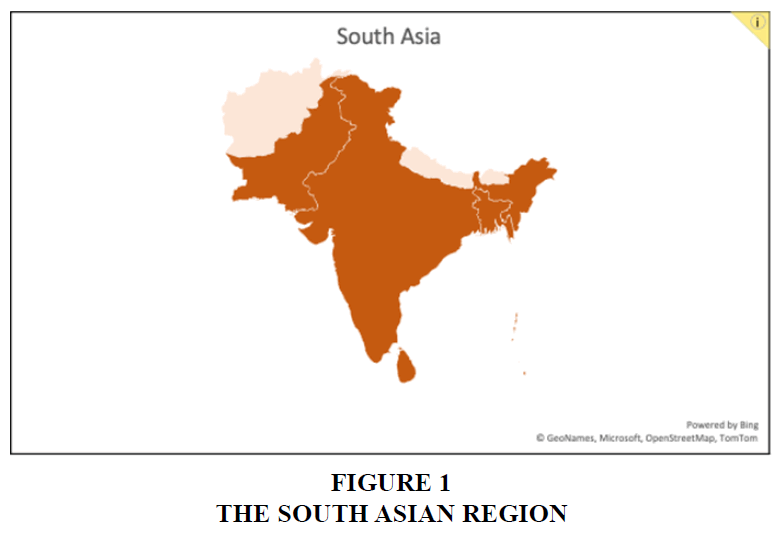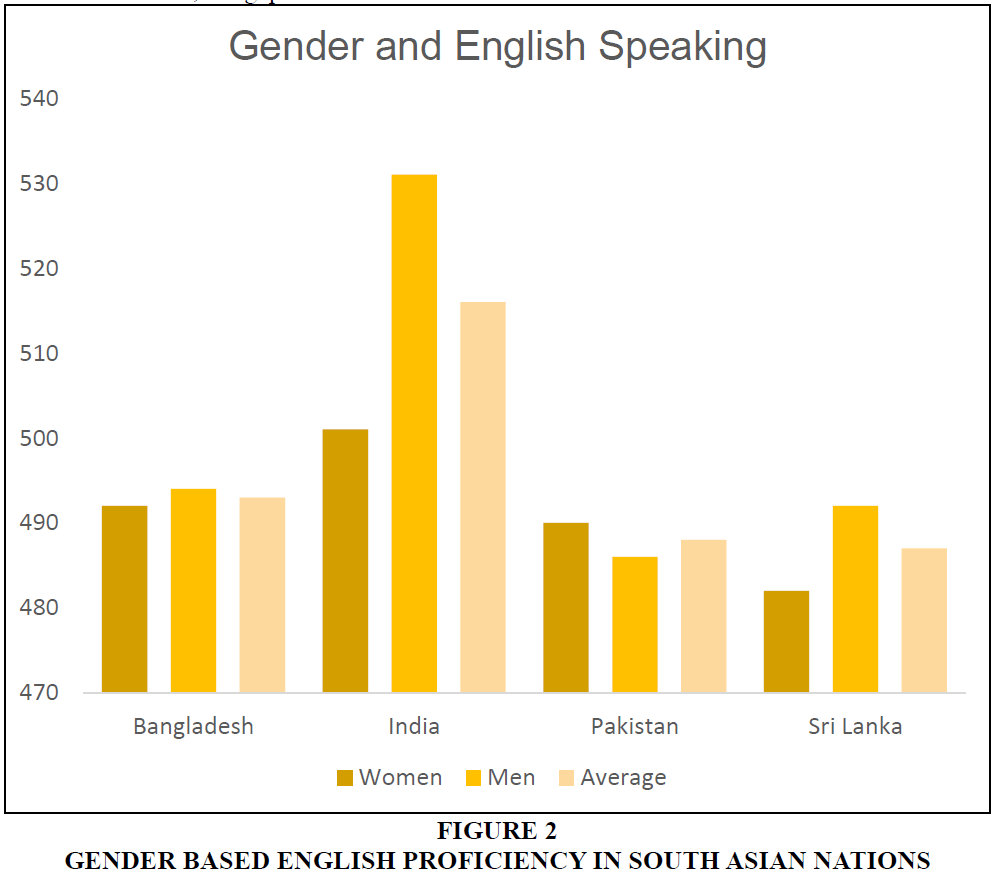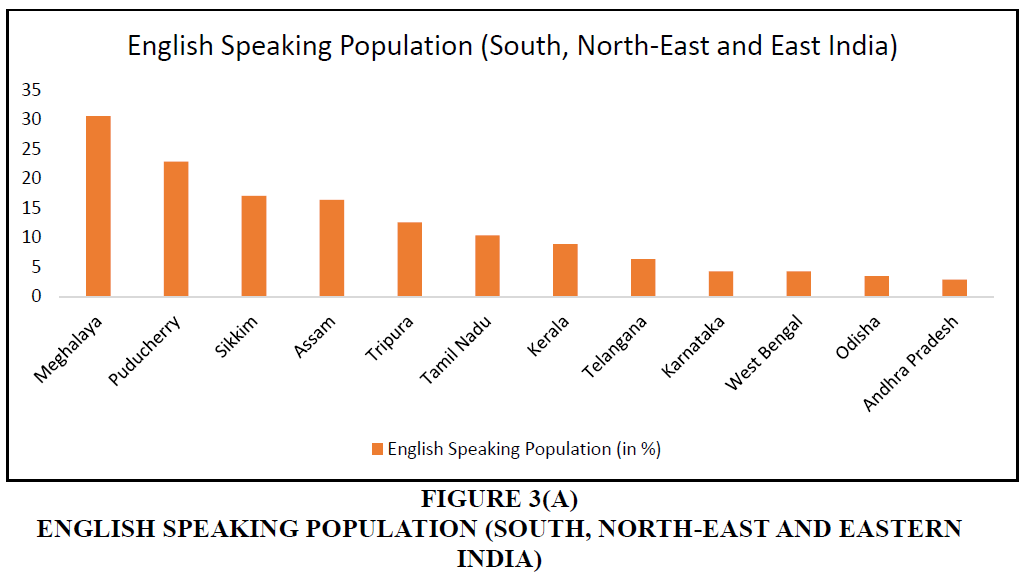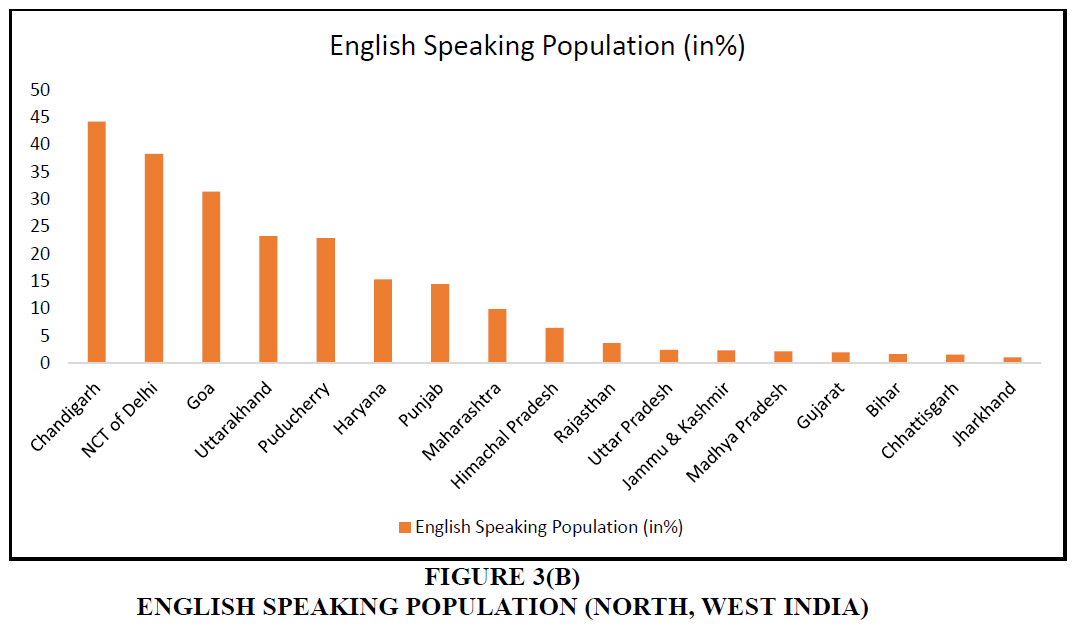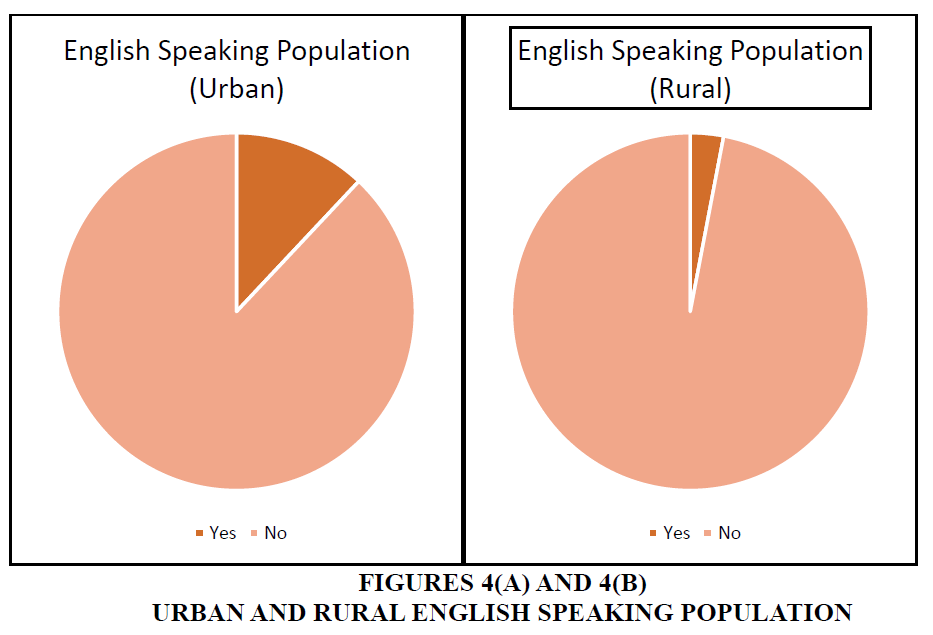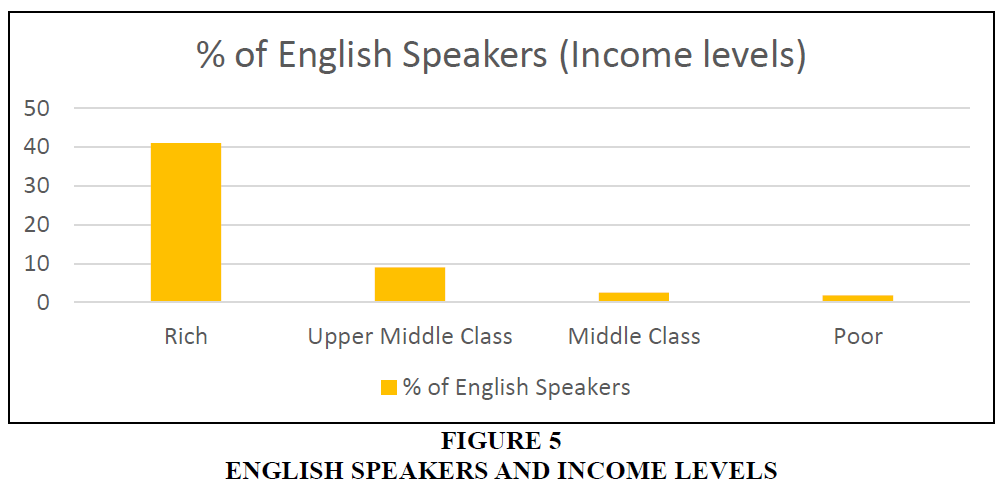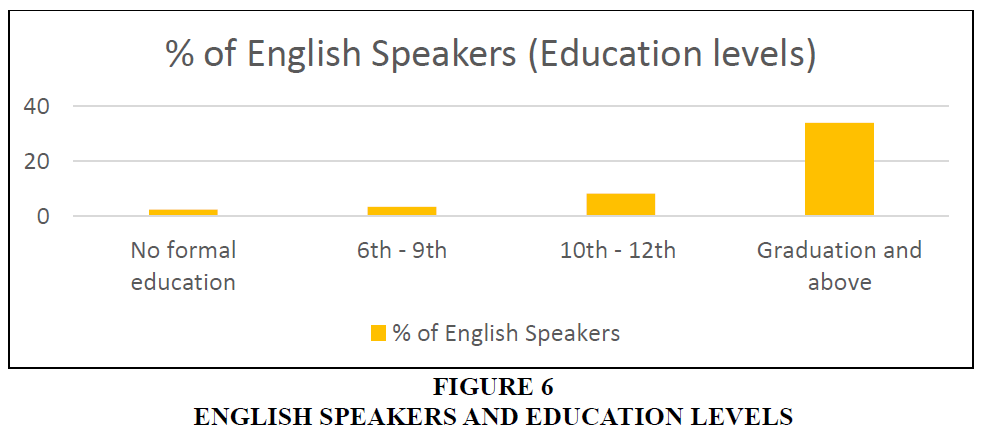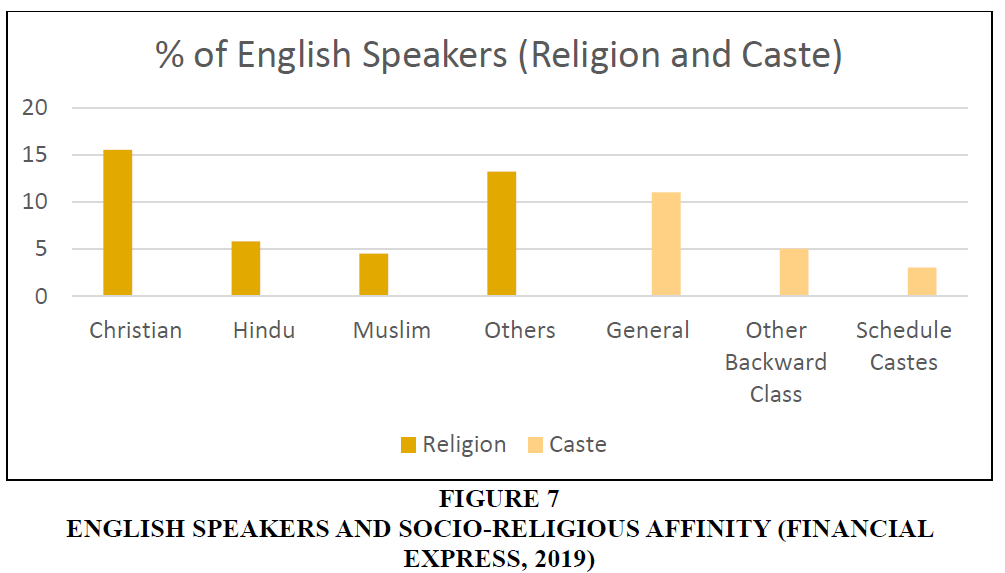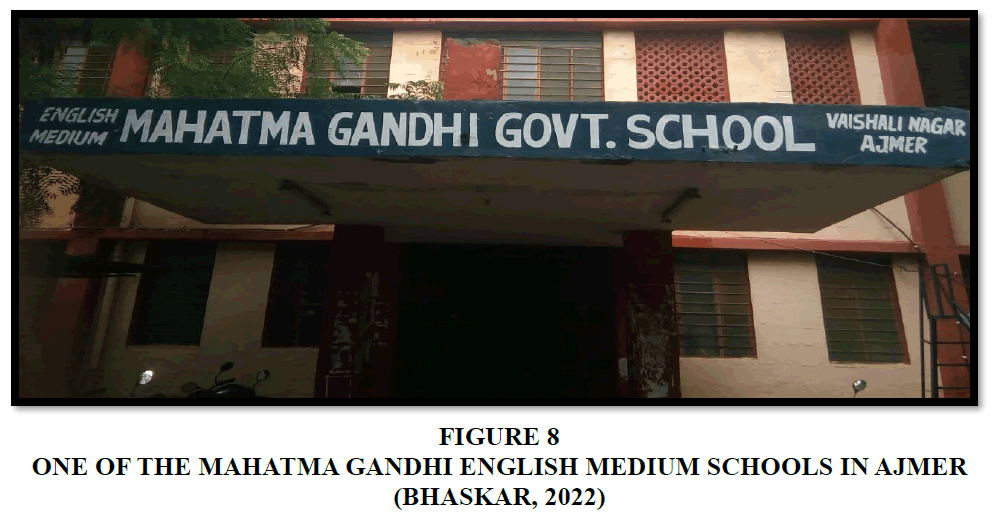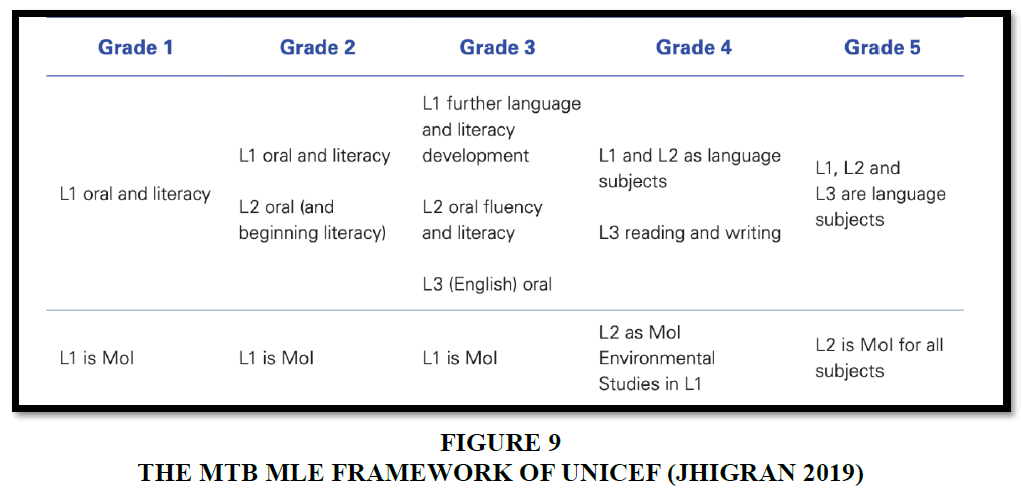Research Article: 2024 Vol: 28 Issue: 4S
Access to English: The Path to Educational Justice
Priyanka Joshi, Manipal University Jaipur
Gulab Chand, Manipal University Jaipur
Urjani Chakravarty, Indian Institute of Management Bodh-Gaya
Pranav Joshi, King’s College London
Citation Information: Joshi, P., Chand, G., Chakravarty, U., Joshi, P. (2024). Access to english: the path to educational justice. Academy of Marketing Studies Journal, 28(S4), 1-14.
Abstract
English has commanded a comparatively significant attention in the South Asian countries apart from being simply a medium of communication. For these countries, English is a historical link to the colonial past and their struggles, and has metamorphosed into the economic link for education, employment and entrepreneurial opportunities from multiple world economies. Despite the numerical strength of English speakers in these countries being in the millions, it presents a distorted picture of the language’s proliferation. Unfortunately, the spread of English language is still limited to the Urban, Upper and the Middle Class and the highly educated. This stands in contravention to the constitutional provisions of these countries, particularly of India, where each citizen has the fundamental right to education. As most higher education (colleges and universities) is conducted in English, the Rural, Agricultural and Economically backward areas are either bereft of such avenues, or the students increasingly devote their time in learning the language, rather than actually reading about their discipline. This paper is an attempt to showcase the relationship between socio-economic determinants such as class, gender and demography and the access to learn English language. The study mainly focuses on the Indian scenario and traces patterns from countries such as Pakistan, Bangladesh and Sri Lanka. Furthermore, the paper also mentions about the economic and social significance of learning the language. Lastly, by taking examples from various state administrations, the paper enlists some practical measures that can be deployed to ease the access of English learning in the region.
Introduction
All organisms on this planet possess a distinct mechanism for communication within their species, and such mechanisms may primarily either be verbal or non-verbal. Linguistic oriented communication is a unique ability of the human beings, which they have employed to their optimal potential. Languages serve as more than just a medium of interaction; they facilitate the exchange of ideas, information and emotions. According to Ethnologue.com (2022), there are over 7,168 languages and dialects in the world. Amongst these bouquet of languages, English is one of the most spoken languages in the world, with over 1.456 billion speakers (native and second language) in 2022 (ethnologue.com).
English is also arguably considered as the global lingua franca, as it is used in all spheres of life, across various government levels, transcending countries and continents altogether. For instance, English is one of the official and/or working languages of major world/ regional organizations like the United Nations, the ASEAN (Association of South East Nations), the European Union and the SAARC (South Asian Association for Regional Cooperation).
With over fifty five countries having English as an official language (apart from the Anglosphere – Australia, Canada, New Zealand, the UK and the USA), it is significant in governance, business and education (Ottawa University). The South Asian countries (Afghanistan, Bangladesh, Bhutan, India, Maldives, Nepal, Pakistan and Sri Lanka) have a rich cultural history of linguistic diversity, and yet English has garnered a significant presence in these countries, albeit in varying degrees. Bangladesh, India, Pakistan and Sri Lanka have millions of inhabitants proficient in English (CIA 2021; CIA 2022a, CIA 2022b; CIA 2022C).
Despite the numerical strength of English speakers in these countries being in the millions, it presents a distorted picture of the language’s proliferation, as such figures are bereft of socio-economic determinants such as class, gender, education levels and level of urbanization. These determinants have unfortunately limited the access of English language to a particular section of individuals (Urban, Upper and the Middle Class and the highly educated) and have left the others (the Rural, Lower class and Economically backward areas) bereft of the same.
The paper attempts to showcase this existent disparity in the access to learning English in India, and the drastic educational and economic consequences it causes for those individuals. Initially, the paper explains the history of English in South Asia and its current relevance in countries like Bangladesh, India, Pakistan and Sri Lanka. Subsequently, by tracing similar patterns in these countries, the paper exhibits the gaps in English language’s proliferation. As these unfair differences are contrarian to the obligations made for the Indian citizens by the Constitution of India, the paper ultimately advocates for the facilitation of English learning across the country, by enlisting exemplary policy measures from the Union and the State governments and recommending additional novel measures for the same.
Research Methodology
The research focus of the study is set primarily on India, along with tracing patterns from countries such as Bangladesh, Pakistan and Sri Lanka. India is among the All four countries have a common historical association with the English language, as these countries were under British colonial rule for decades.
The study has been mainly formulated through secondary data collection. Foremost amongst the sources is the report conducted by the Lok Foundation and the Oxford University in 2019. The report tracked the number of speakers of English Language in India, and analysed the numbers on various socioeconomic determinants such as urbanization levels, income levels, level of educational attainment, etc. Administered by the Centre for Monitoring Indian Economy CMIE, the respondents hailed from 25 states and 4 union territories (UT) of India.
Conducted by the Education First (EF), a Switzerland based education oriented organization; the English Proficiency Index of 2022 is the other valuable report to the study, which showcased the gender-based differences in the levels of English proficiency in the South Asian nations. The index is created for around 111 nations of the world, with over 2.1 million individuals responding to the survey’s questions. The other sources include reports from the British Council and the UNICEF, the CIA Factbook, academic papers and news articles.
The Ingress to Access: Some Insights
The socio-economic privilege coming through the English language, and its access to be learnt, has generated both curiosity and debate amongst the academics. Moreover, the discussion expands its scope as there are distinct observations about varying methods through which access to learning English language can be increased. One of foremost advocates of making English learning easily accessible to all was Philippe Van Parjis (2011), who believed that English is a crucial medium for enhancing equity and democratic progress across the world. Parjis’ ideas came as a significant addition to the thoughts of Brutt-Griffler (2002), who viewed English as a tool of individual empowerment and socio-economic progress. Their views find support in the South Asian context, as the British Council report by Elizabeth Erling (2014) showcases the formations of perceptions of employers/recruiters positively favour those individuals who possess the ability of communicating in English.
A sharp critique to this notion comes in the work of Soler and Gálvez (2022) who posit that Van Parjis viewed the growth of English in a linear manner, and rather subverted the dynamism that society brings through the language. For instance, on the assumption that everyone knows English in the world, whose accents will be more accepted, and which ones won’t be. In the other scenario, the generations who have acquired the knowledge of English would be better off than their older generations, who could not learn the language. Summarily, they challenge Van Parjis by postulating that a complete access to learning English will not solve the problem; it might even exacerbate it.
A middle ground to these contrasts comes in the commentary by Ishikawa and Mc Bride (2019), whose reinforcement of Toh’s (2016) approach to English language education is novel, and holds a unique possibility of worldwide application. They assert the requirement to customise the schema of English teaching to fit the needs of the land where it is taught. Ishikawa (2020) further propounds the notion of English as a Multilingual Franca (EMF) and relocates the English-within-multilingualism in the Japanese context. This approach can certainly gain prominence in the South Asian region, where English serves as a link language between various societies which have different mother tongues.
English in South Asia
The middle and late 16th century witnessed multiple explorations of European citizens in India (the Dutch, the Portuguese, the British and the Danish). Some of these explorers were religious missionaries, who intended to spread Christianity amongst the Indian populace, and that is arguably the form in which English language was introduced in India. These schools were mainly run by the British and the Danish, and they operated till the late 18th century. In the early 17th century, the British East India company formally commenced mercantile trade with the Mughal Empire and set up their factories in India. However, their intent to only trade was replaced by the intent to govern, as they gained victory in the Battle of Plassey (1757).
As the Company was increasingly gaining control of territory and economic resources of the Indian subcontinent (colonial nomenclature of South Asia), the necessity of an efficient, ‘anglicized’ Indian bureaucracy emerged, who would facilitate the colonial administration and act as interlocutors between them and the native subjects. In the early 19th century, Governor – General William Bentinck and Thomas Macaulay formulated the English education policy, which was intended to expand the cohort of ‘brown-skin, white mind’ Indians (Kachru 1994). Through various legislations (Charter Act, 1853) and economic provisions (Charter Act, 1813), the education system was cleverly moulded to incline towards the English language and the English mindset.
Even as the administration was subsequently controlled directly by the British monarch (imperial rule of India from 1858 to Independence), the education policy remained fairly consistent, and it resulted in a steady growth of English speakers and communicators in the entirety of South Asia (Kachru and Nelson 2006). The colonized territory of India gained independence in 1947, as it was partitioned to create the new country of Pakistan.
At present, India and Pakistan are the only two countries to have accorded English with the de jure status of an official language, alongside Hindi and Urdu, respectively. Despite English not having the de jure status in Bangladesh and Sri Lanka, it is considered to be one of the de facto mediums of instruction in educational institutions and a significant language after Bengali and Sinhala and Tamil, respectively. The following table exhibits the English speaking population of these nations according to the last recorded data from their respective governments Tables 1 & 2.
| Table 1 English and its Presence in the South Asian Nations | |||
| Country | Total Population | Total English Speaking Population (mother tounge+second language+ third language) |
Percentage of total population |
| Bangladesh (Census 2011) | 165,323,100 | 19,838,772 | 12% |
| India (Census 2011) | 1,210,854,977 | 128,539,090 | 10.62% |
| Pakistan (Census 2017) | 220,892,331 | 108,044,691 | 48.9% |
| Sri Lanka (Census 2011) | 21,803,100 | 5,189,137 | 23.8% |
| Table 2 Major Policy Provisions for Education in India (Borg et al 2022) | ||
| Provision | Year | Measures |
| Secondary Education Commission | 1952-53 | • Importance of mother tongue and English. • English to be taught in all Secondary schools. |
| Kothari Commission | 1964-66 | • English to serve as a link language to higher education. • English is useful to be studied in secondary and higher secondary levels. • Proposed three-language formula |
| National Education Policy | 1968 | • Introduced three language formula. • Emphasized on promoting both Hindi and English • Hindi + English+ Other Indian Language |
| 42nd Constitutional Amendment | 1976 | • Education becomes a ‘concurrent list’ subject. • States in control of English teaching |
| National Education Policy | 1986 | • Emphasis on education in the mother tongue • Increased role of universities in strengthening ELT |
| National Curriculum Framework (2023) | 2005 | • Recognition of multilingualism as a resource • Introduction of SLA frameworks and approaches to conceptualise English education. |
| National Focus Group on Teaching of Indian Languages | 2006 | • English becoming integral to Indian socio-cultural matrix. • English as a language of mobility and aspirations. • Teaching of English to interweave with teaching of Indian languages. |
| Rashtriya Madhyamik Shiksha Abhiyan (RMSA) | 2009 | • Quality enhancement of English Teaching |
| Right to Education Act | 2009 | • 25% of all students in a classroom to be from the Economically Weaker Sections. |
| Scheme to provide quality education in Madrasas | 2014 | • Supporting Madrasas to introduce English among other subjects. |
| Samagra Shiksha Abhiyan (SSA) | 2018 | • Stata Councils of Educational Research and Training to have separate cells and faculties for English education. • English achievement in Grade 10 to be measured by National Achievement survey. |
| National Education Policy | 2020 | • Bilingual teaching-learning materials in mother tongue and English. • Three language formula from the foundational stage. • Funding to alternative schools to introduce English among other subjects. |
Gender and English Speaking (Proficiency) in South Asia
The global average proficiency, according to the English Proficiency Index (2022), was at 512 points. Amongst the nations under consideration, India is the only nation which crossed the average mark by scoring 516 points, thereby gaining it the status of ‘moderate proficiency.’ All the other three countries have a ‘low proficiency’ ranking in the index. Following are the proficiency average scores of the countries:
1. India – 516 points
2. Bangladesh – 493 points
3. Pakistan - 488 points
4. Sri Lanka- 487 points
Pakistan is the only South Asian country where women fared better than the men in terms of proficiency capabilities by four points. Bangladesh had the minimum gap between its men and women (by two points favouring the men). On the other hand, India (20 point) and Sri Lanka (10 point) have significant differences between the proficiency of their people, and in both the countries, the gap favours the men.
Linguistic Provisions in India
Post-independence in 1947, India’s constitution makers were posed with potent questions around the language-based rules, as they wanted to promote certain languages, along with recognizing and catering to the existent linguistic diversity of the country. Despite diverging opinions on the same, they formulated a policy that optimally balanced the entire spectrum of views on this issue.
Even though Hindi (with Devanagari script) was recognised as the official language of the Indian Union, (Art. 343, Constitution of India) English was also accorded with the status of an official language of the Union. The relevance of English language in India was to be reviewed after fifteen years of the constitution’s adoption (November 1964). By that time, English had emerged as a link language between the ‘Hindi Heartland’ and the ‘Dravidian’ states. Therefore, after carefully considering the political and administrative significance of English, it was retained as the official language since. At present, English is the other de jure official language alongside Hindi.
Furthermore, twenty-two languages (including Hindi) are considered as the official languages of India, which exhibit the lengths to which the lawmakers have gone to preserve and protect the country’s linguistic heritage. Most of these official languages are used as the primary language of communication in the state governments. All these provisions are mentioned in Articles 343 to 348 of the Constitution of India.
Access to English - India
English has been accorded with a distinct socioeconomic significance in the South Asian countries, and it has also furthered political amicability by enabling the retention of the original linguistic diversity. Even though these countries collectively boast of a major chunk of English speakers, the access to learning the language is highly concentrated and mainly skewed in favour of the population’s subset.
According to the survey conducted by the Lok Foundation and the Oxford University, the national average (4 Union Territories and 25 states) of English communicators came to approximately 12.2%. in 2019. As showcased in Figures 1 and 2, the Union Territory of Chandigarh has the highest proportion of English speakers in India, and the state of Jharkhand has the least English speaking population in the country. Generally, the southern Indian states and the north-eastern states have a higher proportion of English speakers compared to the northern states. There are however, some surprising exceptions in the trend, as the Union Territory of Chandigarh, the states of Haryana, Punjab and Uttarakhand have some of the highest proportions of English speakers in their areas. On the contrary, the state of Andhra Pradesh has a dismally low populace communicating in English, which is an anomaly for a southern Indian state.
Urbanization, Income Levels and English Speaking
In India, English happens to be an urban language, as 12% of urbanized Indians claimed to have the ability to communicate in the language. On the contrary, only 3% of the rural Indian citizens could confidently assert that they know how to speak English. This observation is a clear reflection of the geographical distribution, as Chandigarh is a highly urbanized territory and Jharkhand happens to be dominated by the rural population Figures 3a & 3b.
English has long been associated with the Indian denizens who are considered to be the economic elite of the country, and the survey substantiates that observation. Amongst those surveyed, roughly 41% of the ‘rich’ Indians and 9% of the ‘upper middle class’ Indians claimed to have the ability of conversing in English language. On the contrary, barely 2.5% of the ‘middle class’ respondents and 1.8% of the ‘poor’ Indians could demonstrate their communication skills Figures 4a & 4b.
Education, Society and English Speaking
Levels of educational achievement also positively correlate with the English language communication in India, i.e., there are increasing chances of an Indian conversing in English as their educational levels advance. Amongst those who did not have a formal education, barely 2.4% of the people could speak in English. This proportion increases to 3.3% for individuals who have studied between the grades 6th and 9th. Amongst those who have studied anywhere between 10th to 12th grades (Matriculation and Senior Secondary), about 8.2% of them could speak in the language. If the respondents come as a graduate or a postgraduate, there is more than one third of a chance (approximately 34%), that the individual has communication abilities in English Figures 5-9.
If the linguistic prowess of English speakers is looked from the caste dimension, then the language is still spoken in the greatest proportion amongst the General (unreserved castes), as about 11% of them could speak in the language. This proportion depletes to approximately 5% and 3% for the Other Backward Castes and the Scheduled Castes/Tribes respectively. From the perspective of religion, Christians are predictably the largest English speaking community in India, as around 15.5% of them claimed to know how to speak in English. Furthermore, the Hindus and the Muslims are the other major communities with a sizeable proportion of English speakers, at 5.8% and 4.5% respectively. All the other communities combined had around 13.2% of respondents as English speakers.
Cross-variable Relationships with English Speakers and Specific Regions
As we look at these variables and draw some relationships between these observations, some fascinating insights come out, which are as follows:
1. States and Union Territories such as Chandigarh, National Capital Territory of Delhi, Haryana, Punjab and Maharashtra boast of English speakers due to two reasons. All these entities have some of the wealthiest classes of the Indian citizens residing in them. Furthermore, since Chandigarh and the NCT of Delhi are purely urban territories, they have a higher English speaking population.
2. States and Union territories in the north-east (Meghalaya and Assam) and the south (Puducherry) of India have a high proportion of English speakers. These entities draw such a proportion due to the sizeable portion of their population following Christianity. The same also applies to the state of Goa, which traditionally has been leaning towards the religion.
3. States and Union Territories like Goa, Uttarakhand and Puducherry are major tourist attractions for overseas travellers into India. In order to cater to these tourists, the population of these areas have been steadily adapting to speaking English.
Major Policy Provisions for Education of English in India
The survey’s data exhibited the disparity in the proportion of English speakers in India. Increasing the access and quality of learning English in India is the sole way in which more Indians can be equipped with the linguistic skill. Following are some of the significant policy provisions implemented by the Government of India and other national bodies that have shaped the education system of India, particularly with regards to English language education:
As noted in the policy provisions, Education as a subject comes under the common purview of both the union and the state governments. Apart from the measures taken by the union government, there have been increasing efforts from the state governments to promote English language education, and following are some examples of the same:
a. English medium schools: The governments of Rajasthan (Ashok Gehlot administration) and Andhra Pradesh (Jagan Mohan Reddy administration) have launched the programmes of “Mahatma Gandhi English Medium School” and the “Mana Badi Nadu Nedu” respectively. Both these programmes aim at investment in infrastructure and teachers that support English language education for children accessing government school education. In both these states, the ‘public’ education system is catering particularly to children with negligible economic resources. Furthermore, the governments of Uttar Pradesh and Chhattisgarh have increased the number of English medium schools in their respective states.
b. Capacity building programmes: The governments of Maharashtra and Delhi (National Capital Territory) had partnered with organizations such as the British Council and Burlington English, respectively. According to the British Council, they had multiple programmes over a decade with the Maharashtra government, that concluded in 2021. This programme generated more than 50,000 quality English educators teaching in ‘public schools’, benefiting approximately 4.38 million learners. (Telegraph India, 2021). In Delhi, the partnership with Burlington English has been benefiting around 4,400 students studying in 37 BR Ambedkar Schools of Specialised Excellence.
c. Mother- Tongue- Based Multilingual Programme: The UNICEF (United Nations Children’s Fund) has an ongoing program in the state of Odisha since 2005, which focussed on improving language proficiency by strengthening the student’s grasp primarily on the mother tongue. In Odisha’s case, English is L3 (Language 3), which is resonant in many other Indian states, where multilingualism prominently exists. Furthermore, the scheme can be easily customised for those states where English is the second language, and the third language can be either foreign or Indian. The programme has been operating in 1,500 schools benefiting approximately 70,000 children . After witnessing the success of this programme, the Odisha government formulated the MLE policy in 2014, which was designed on the lines of this programme.
Recommended Measures
Alongside these commendable efforts from the state governments, there are some other measures that should be introduced to increase the number of Indians educated in English. The suggested measures are as follows:
1) Familiarization: The National Curriculum Framework defines curriculum as ‘ the entirety of the organized experience of students in any instructional setting towards educational aims and objectives.’ In India’s case, the curriculum of languages should then adhere to the vision of the Indian education system espoused by the National Education policy, which is as follows:
“ This National Education Policy envisions an education system rooted in Indian ethos that contributes directly to transforming India, that is Bharat, sustainably into an equitable and vibrant knowledge society, by providing high quality education to all, and thereby making India into a knowledge superpower.”
In other words, it implies that the curriculum be designed in. accordance to facilitate the physical, mental, spiritual, cultural and social development of the learner. To do so (NCRT, 2023) for language learning, we recommend the adaptation of the learner’s learning material to Indian writings, landscapes, epics, nomenclatures, characters, songs, poems etc. The familiarity of these elements in the literature will facilitate English language learning and the student will be interested in reading the material on a regular basis.
2. Favourable Classrooms: The classrooms are an indispensable entity for systematic education. However, they cause monotony and boredom. Therefore, the teachers are suggested to create the classroom into any set-up for the lecture/lesson (setting up a lecture in places like a bank, a zoo or a tourist place) so as to enhance interest and this also allow for interactive activity for the learners. Apart from changing the set-up, actual games should be organised to teach topics such as prepositions. In this manner, even schools with limited resources to develop classrooms into language laboratories.
Teacher Training
• Continued and frequent language teachers’ faculty development programmes or webinars must be arranged. The well-updated teachers will be able to better devise lesson plans and execute them further. As there is a limitation to human thought processing, an exposition to new ideas and experiences shared through fellow participants in seminars/ workshops etc will facilitate teachers in terms of saving time and effort.
• Teachers must also be continuously checked on their pronunciations and accents.
• Special mentions or merits must be awarded to the teachers who incorporate activity based learning.
• Students’ and parents’ feedback must be noted to understand their expectations and problems (if any) from the language teachers. Clarity in the teacher’s comprehension will ease the teachers in addressing the learner’s requirements in an accommodative manner.
3. Student Empowerment
• For improved language acquisition, it is inevitable to have optional language use. Therefore, learners must be comforted, counselled, and encouraged to use English speaking and thereby gain fluency. Their anxiety must be reduced and they can be awarded by material indicators (stars, bands or badges) of encouragement for initiating conversations and enhancing participation in English language.
• The learner can use the ‘mirror talk’ technique by installing a mirror for practising in front of it, prior to delivering a speech or an oration.
• Language learning strategies must be introduced to the learners.. Additionally, inventories and instruments must be periodically employed to make the learners aware of their progress.
4. Introduction of Digital Media
• The pandemic has impacted majority of schools to use digital mode of learning. However, in rural areas, suburban areas or economically challenged institutions, uninterrupted internet services are posing challenges to digital connectivity. This must be resolved by the government’s support.
• Access to digital libraries and lesson recordings must be encouraged. The students will benefit when they can learn by watching how to speak (as they may not have a competent speaker outside the school for interaction).
5. School to Society
• Schools must organize social events to encourage interaction in the English language.
• Mentors (retired teachers, professionals or volunteers) should be invited to such events as they can regularly devote some time to interact with the learners. Furthermore, the students can learn from the mentors experience and utilise it to enhance their language skills.
Conclusion
English is one of the major languages of the world, and it continues to retain its influence in the same regard. Even as the language was introduced for ulterior motives of the colonialists, the numerous countries of the world, and particularly of South Asia, accustomed themselves to use English. Amongst the plethora of languages spoken by the Indians, the Pakistanis, the Bangladeshis and the Sri Lankans, English became the link language which facilitated in fostering both intra-national and international communication.
Presently, there are millions of English speakers within these countries, and they form a formidable bloc amongst the Anglophones in the world. However, these numbers only present one aspect of the reality, as the people who can speak the language are concentrated in various socio-economic brackets. On a broader scale, there are significant gaps in the levels of English language proficiency amongst the men and women of South Asian countries. With the sole exception of Bangladesh, the gap disproportionately favours the men for the other countries.
There is a dismal access of English language’s learning across India, as substantiated by the Lok Foundation- Oxford university survey. There was a disproportion in the number of people who claimed that they could speak English across geography, caste, class, levels of education and urbanization. Furthermore, there are cross-variable relationships that have cemented the presence of English language at some concentrated pockets of India. At a time when English language learning has proven to be a skill that leads to better economic opportunities, the Indians who are from low-income families and/or rural background have a clear disadvantage as their access to learning English is low.
The study’s attempt was to showcase the very disparity that exists in the access to learning English language. Additionally, the paper enlisted the major policy provisions in India which focused on the English language’s teaching and learning. Ultimately, the study provided numerous recommendations that will ensure increasing access to learning the language.
Ethics Statement
The study does not involve the participation of direct respondents. All materials used for the article are substantially referenced and the writers have (to the best of their knowledge) avoided any conflicting material.
References
Bhaskar, D. (2022). Dainik Bhaskar; Dainik Bhaskar Corporation.
Borg, S., Padvad, A., & Nath, P.K. (2022). English language teaching, learning and assessment in India: Policies and practices in the school education system. In ELT Learning and Assessment in India (pp. 1–48). British Council.
CIA. (2021). India. Cia.gov.
CIA. (2022a). Bangladesh (CIA, Ed.). CIA.gov; Central Intelligence Agency.
CIA. (2022b). Pakistan - The World Factbook (CIA, Ed.).
CIA. (2022c). Sri Lanka - The World Factbook. Central Intelligence Agency.
English | Ethnologue Free. (n.d.). Ethnologue (Free All); Ethnologue. Retrieved June 1, 2023, from https://www.ethnologue.com/language/eng/
Erling, E. (2014). The Role of English in Skills Development in South Asia: Policies, Interventions and Existing Evidence (pp. 1–32). British Council.
Financial Express. (2019). Why public schools must shore up English teaching. Financialexpress.
Ishikawa, T., & McBride, P. (2019). Doing justice to ELF in ELT: comments on Toh (2016). Journal of English as a Lingua Franca, 8(2), 333–345.
Kachru, B.B. (1994). English in South Asia. De Gruyter EBooks, 627–678.
Kachru, Y., & Nelson, C. L. (2006). World Englishes in Asian Contexts. In JSTOR (pp. 9–22, 153–165). Hong Kong University Press.
National Curriculum Framework for School Education (2023).
Ottawa University. (n.d.). The 55 bilingual countries in the world. Compendium of Language Management in Canada (CLMC); Ottawa University.
Parjis, P. V. (2011). Linguistic Justice for Europe and for the World. Choice Reviews Online.
Indexed at, Google Scholar, Cross Ref
Soler, J., & Morales-Gálvez, S. (2022). Linguistic justice and global English: theoretical and empirical approaches. International Journal of the Sociology of Language, 2022(277), 1–16.
Telegraph India. (2021). British Council celebrates a decade of special teacher training programmes in Maharashtra.
Toh, G. (2016). Doing justice to an English as a lingua franca paradigm. Journal of English as a Lingua Franca, 5(2).
Indexed at, Google Scholar, Cross Ref
Received: 11-Jan-2024, Manuscript No. AMSJ-24-14342; Editor assigned: 12-Jan-2024, PreQC No. AMSJ-24-14342(PQ); Reviewed: 20-Mar-2024, QC No. AMSJ-24-14342; Revised: 29-Mar-2024, Manuscript No. AMSJ-24-14342(R); Published: 30-Apr-2024
